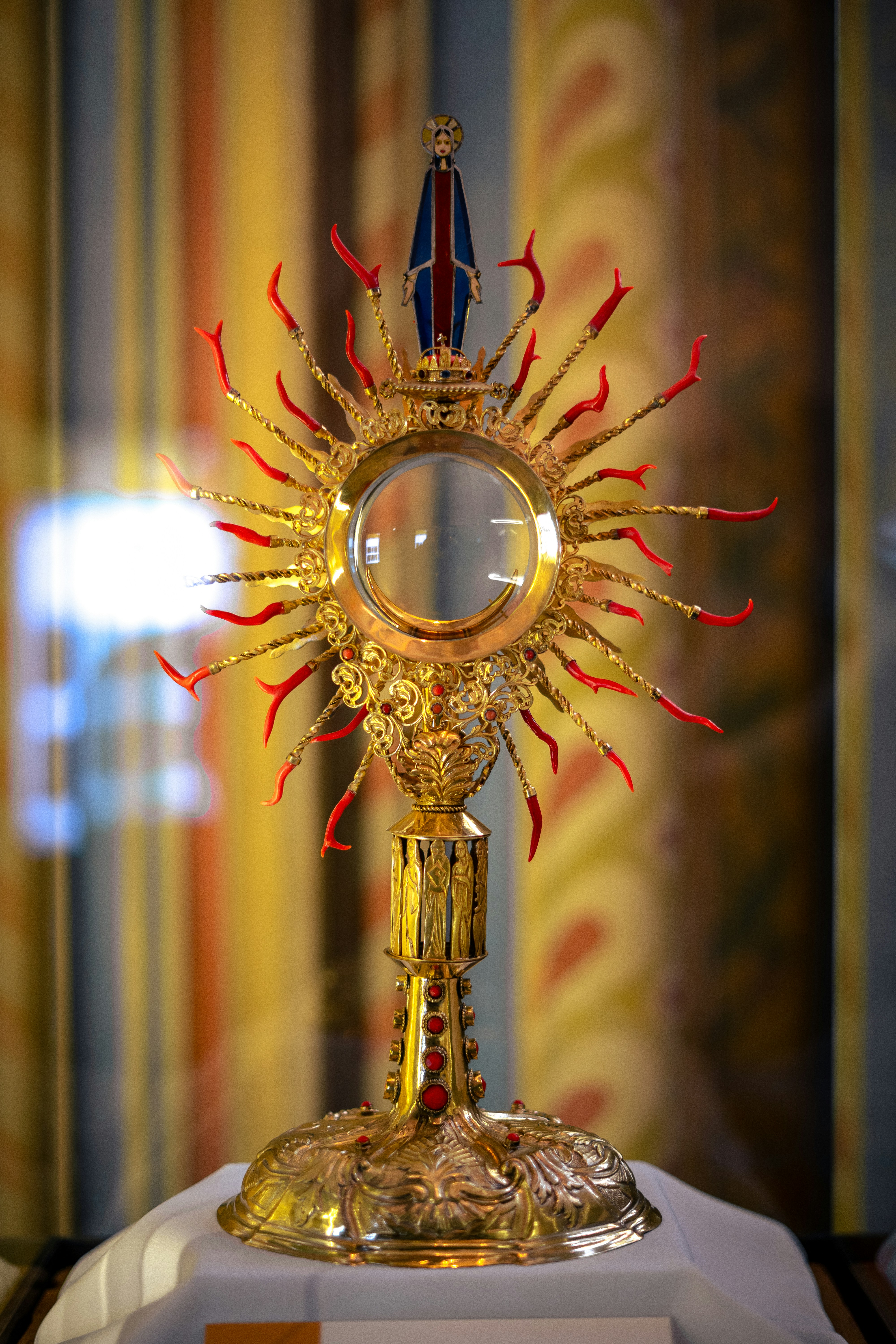
Introduction to the Ark of the Covenant
The Ark of the Covenant is a revered and enigmatic artifact that plays a central role in Judeo-Christian religious traditions. According to the Hebrew Bible, it is described as a gold-plated wooden chest, containing sacred items, including the tablets bearing the Ten Commandments. The significance of the Ark lies in its representation of God’s covenant with the Israelites, symbolizing His divine guidance and protection during their journey through the desert and into the Promised Land.
Originating in the Book of Exodus, the Ark’s construction was directed by God, with specific dimensions and materials meticulously outlined to Moses. It was housed within the Tabernacle, a portable sanctuary used by the Israelites during their wanderings. The Ark served not only as a holy object but also as a tangible manifestation of God’s presence among His people. This critical aspect of the Ark reinforced the Israelites’ faith, acting as a reminder of their covenant with God and His unyielding support.
Throughout biblical narratives, the Ark of the Covenant is associated with significant events, such as the parting of the Jordan River and the fall of Jericho’s walls. Its presence was believed to instill fear in adversaries and bolster the morale of the Israelites during battle. The Ark’s power and holiness were so immense that direct contact was strictly forbidden; only designated individuals, such as the high priests, could come near it. The reverence surrounding the Ark highlights its importance within the religious framework, embodying themes of faith, obedience, and divine connection.
In conclusion, the Ark of the Covenant stands as a key symbol in both Jewish and Christian theology. Its role as a sacred relic of faith extends beyond the mere physical object, encapsulating deep spiritual meaning and historical significance to those who cherish its legacy.
Historical Background and Biblical Significance
The Ark of the Covenant stands as a pivotal artifact in the narrative of the Israelites, meticulously crafted according to divine instructions provided to Moses. This sacred object, described in the Book of Exodus, embodies the covenant between God and His people, serving not only as a religious symbol but also as a representation of divine presence among the Israelites during their journey through the wilderness. Its construction, which involved materials such as acacia wood and gold, signifies the importance placed upon the Ark, both physically and spiritually.
Throughout Israelite history, the Ark has been closely associated with significant figures like Joshua, who, under God’s command, led the Israelites across the Jordan River. The Ark, carried by the priests, was instrumental during the Battle of Jericho, where its presence helped to bring down the city’s walls, illustrating its power as a divine instrument in warfare and conquest. Following the conquest, the Ark found a temporary resting place at Shiloh, becoming central to worship and religious practices.
The significance of the Ark continued to flourish during King David’s reign, where it was relocated to Jerusalem, marking it as the city’s spiritual centerpiece. This act not only enhanced the unity of the nation but also underscored the intertwining of politics and religion in ancient Israel. Furthermore, Solomon, David’s successor, constructed the First Temple, in which the Ark was housed, thus solidifying its role as an essential symbol of faith. Its presence within the inner sanctum of the Temple illustrated the profound reverence held for the Ark and its capacity to connect the Israelites directly with God.
In reflecting on these historical narratives, it becomes evident that the Ark of the Covenant is more than a mere relic; it is a storied testament to the faith and collective identity of a people. The journey of the Ark throughout key historical moments showcases its enduring legacy as a sacred symbol central to the ancient Israelite experience.
Physical Description of the Ark
The Ark of the Covenant, a significant artifact in religious history, is described in the scriptures with specific details concerning its dimensions and materials. According to the Book of Exodus, the Ark was constructed from acacia wood, a durable and resistant material often associated with protection and longevity. This wood was chosen not only for its practical qualities but also for its symbolic representation of strength and resilience in the presence of the Divine.
In terms of size, the Ark measured approximately 2.5 cubits in length, 1.5 cubits in breadth, and 1.5 cubits in height, which translates to about 45 inches long, 27 inches wide, and 27 inches high. These dimensions reveal an object that, while not excessively large, was designed to be imposing and to evoke reverence among those who encountered it. Such measurements were indicative of its role as the dwelling place of God’s presence on Earth, serving as a central point for worship and communion.
The craftsmanship of the Ark was further exemplified by its lavish overlay of pure gold, meticulously applied both inside and out. This golden facade symbolized divinity and purity, reinforcing the sacred nature of the Ark. The lid of the Ark, known as the Mercy Seat, featured two intricately designed cherubim, each facing inward, with wings extended above. These cherubic figures not only served as guardians of the sanctity of the Ark but also represented the connection between the heavenly and earthly realms. Their detailed design provided an aesthetic that was both haunting and captivating, contributing to the Ark’s spiritual allure.
Overall, the physical attributes of the Ark of the Covenant reflect a deep intention behind its design, merging artistic excellence with profound religious significance. Through its materials, dimensions, and intricate design elements, the Ark stands as a testament to the faith and craftsmanship of the ancient Israelites.
The Ark’s Journey and Locations
The Ark of the Covenant, a sacred relic deeply treasured in Judeo-Christian tradition, has undergone a remarkable journey since its creation. Initially, the Ark was housed within the Tabernacle, a portable sanctuary constructed by the Israelites in the wilderness, as prescribed in biblical texts. It served as a divine symbol, representing God’s presence among His people, and was meticulously crafted to hold the tablets of the Ten Commandments, Aaron’s rod, and a jar of manna, thereby embodying the covenant between God and Israel.
As history progressed, the Ark faced significant challenges, most notably its capture by the Philistines during the Battle of Aphek. The Philistines, recognizing the Ark’s spiritual significance, took it to their territory, specifically to Ashdod, thereby marking an extraordinary shift in its fate. However, the Philistines experienced devastating misfortune, which they attributed to the Ark, leading them to return it to the Israelites after seven months. This event further underscored the Ark’s emblematic nature, as it was perceived to bring blessings and curses alike, depending on its rightful ownership.
Upon its return, the Ark was eventually settled in Kiriath-Jearim before being transferred to Jerusalem during King David’s reign. This crucial relocation not only reinstated its central role in Israelite worship but also highlighted its association with God’s divine guidance. The Ark finally found its resting place in Solomon’s Temple, further solidifying its significance as a focal point of faith and worship among the Israelites. Shahids indicate that this Temple became a symbol of peace and prosperity, with the Ark representing the ultimate pinnacle of divine presence and covenantal promise. The journey of the Ark of the Covenant underscores its vital importance throughout history, serving as a testament to the intricate relationship between faith and the physical manifestations of that faith.
Theological Significance of the Ark
The Ark of the Covenant occupies a profoundly significant position within the theological framework of Judeo-Christian beliefs. Established as a physical manifestation of God’s promise, the Ark serves as a testament to the covenant between God and the Israelites. It is not merely a ceremonial object but embodies the divine presence in the midst of the people, symbolizing a direct link between the divine and humanity. The Ark is viewed both as a powerful reminder of God’s laws, encapsulated in the tablets of the Ten Commandments, and as a representation of His unwavering commitment to His chosen people.
In numerous narratives throughout the Hebrew Scriptures, the Ark plays a pivotal role in various rituals and ceremonies that underscore its significance. One primary example is the Day of Atonement, during which the High Priest would enter the Holy of Holies and sprinkle the blood of sacrifice on the Ark’s mercy seat. This act was vital in seeking forgiveness for the sins of the Israelites, marking a profound moment of atonement and reconciliation between God and His people. During such rituals, the Ark was not only a physical artifact but also a conduit for divine grace, illustrating God’s readiness to dwell among those who are penitent.
The concept of God’s dwelling is further emphasized in the instructions given for the Ark’s construction, where it is described as being placed within the Tabernacle, a portable sanctuary. This notion reflects the theological idea that God desires to reside among His people, providing guidance, protection, and blessings. Thus, the Ark serves as a focal point for worship and a constant reminder of the sacred relationship established through divine covenant. Overall, the theological implications surrounding the Ark of the Covenant extend far beyond its physical existence, resonating deeply in the faith and practices of the Israelite community and continuing to hold significance in contemporary religious discussions.
Cultural Impact and Representations of the Ark
The Ark of the Covenant, a religious artifact from the Hebrew Bible, continues to resonate within various cultural spheres, transcending its initial religious significance. Beyond its origins, the Ark has emerged as a profound symbol represented in diverse art forms, literature, and popular culture. In many ways, the portrayals of the Ark convey a sense of divine power, mystery, and reverence that captivates audiences across generations.
Artistic representations of the Ark can be traced back to ancient times, where depictions were primarily found in religious settings or manuscripts. The intricate designs and motifs associated with the Ark have inspired numerous artists, who have sought to capture its grandeur and sacredness in paintings, sculptures, and architectural works. For instance, Michelangelo and other Renaissance artists integrated the Ark’s imagery in their masterpieces, often portraying it as a conduit of divine grace. Such portrayals underscore the Ark’s role as a symbol of covenant and divine presence, appealing to not only religious sentiments but also to aesthetic appreciation.
In literature, the narratives surrounding the Ark have been explored by various authors, providing contemporary interpretations of its significance. The mystery of the Ark often serves as the focal point in adventure novels, manifesting in themes that deal with sacred relics and quests for truth. Notably, the Ark’s representation in popular culture—such as films like “Raiders of the Lost Ark”—has further cemented its iconic status. These cultural narratives tend to amplify the Ark’s aura of divine omnipotence and its association with holiness and providence, translating ancient beliefs into accessible storytelling for modern audiences.
Moreover, folklore surrounding the Ark persists, with tales reflecting local culture and beliefs, varying from myths about its resting place to legends about its powers. This persistent cultural engagement with the Ark of the Covenant solidifies its role not merely as a historical artifact but as a dynamic symbol of faith and mystery that remains relevant today.
Modern Interpretations and Theories about the Ark
The Ark of the Covenant has long been regarded as one of the most intriguing and mysterious artifacts in religious history. Modern interpretations and theories concerning its fate have flourished, reflecting a blend of academic inquiry, archaeological exploration, and spiritual reverence. One prominent theory suggests that the Ark may have been hidden away to protect it from invaders, particularly during the Babylonian conquest of Jerusalem. According to this perspective, various locations have been proposed, including Ethiopia, where the Ethiopian Orthodox Church claims to house the Ark in the Church of St. Mary of Zion. This claim fuels both religious devotion and historical curiosity, further enhancing the appeal of the artifact.
Archaeological pursuits to locate the Ark have gained traction over the years, with multiple excavations occurring in areas such as Jerusalem and the vicinity of the Temple Mount. Scholars and archaeologists often speculate that the Ark, if found, could shed light on ancient practices and beliefs, clarifying its significance in both Jewish and Christian contexts. These explorations frequently attract public interest, spurring discussions in academic circles about the historical veracity of the biblical narrative surrounding the Ark.
The mystery of the Ark continues to inspire various interpretations that span mythology and history. Scholars often delve into biblical texts to analyze references to the Ark, while others ponder its symbolic meanings, suggesting it represents a connection between humanity and the divine. In contemporary society, the Ark serves as a metaphor for the pursuit of faith, certainty, and truth amidst ambiguity. As theories continue to emerge, the Ark of the Covenant remains a pivotal subject of study, captivating both religious adherents and secular historians alike. The ongoing quest for understanding the Ark encapsulates the intersection between belief, history, and the enduring human fascination with the unknown.
The Ark of the Covenant in Popular Culture
The Ark of the Covenant, an ancient and sacred relic, has captured the imagination of filmmakers, authors, and artists for decades. This profound object, deeply rooted in religious history, is frequently portrayed in various mediums that explore themes of faith, power, and the unknown. Notably, movies like ‘Raiders of the Lost Ark’ have profoundly influenced the public’s perception of the Ark, merging historical context with thrilling adventure. In this 1981 classic, the Ark is depicted not just as a religious artifact but as a source of supernatural power, an interpretation that contributes significantly to its mystique in popular culture.
Beyond cinema, the Ark of the Covenant has found its way into literature, with various novels and historical texts attempting to unravel its mystery. Authors often weave intricate narratives that explore the origins, significance, and fate of the Ark, sparking discussions about its theological and archaeological implications. Books like “The Lost Ark of the Covenant” invite readers to engage with the story of the Ark while speculating on its historical existence and whereabouts. These literary works highlight the enduring allure of the Ark, often portraying it as a symbol of divine presence and a representation of humanity’s quest for understanding transcendental truths.
Moreover, the Ark has inspired numerous pieces of artwork, from paintings to sculptures, emphasizing its status as a cultural icon. Artists utilize various styles to convey the Ark’s religious significance and its broader implications in contemporary society. The Ark of the Covenant thus serves not only as a religious artifact but also as a profound symbol that resonates with themes of exploration, spiritual longing, and cultural identity. Its place in popular culture underscores a collective fascination that continues to intrigue and inspire, prompting both admiration and inquiry into this enigmatic relic.
Conclusion: The Enduring Legacy of the Ark
The Ark of the Covenant stands as one of the most enigmatic and revered relics in religious history, symbolizing faith, divine presence, and the covenant between God and His people. Its significance transcends mere historical context; it embodies deep spiritual meanings that continue to resonate with various cultures and religious traditions. Throughout the centuries, the Ark has inspired countless narratives, artistic representations, and theological discussions, reflecting its profound impact on both the past and present.
Historically, the Ark is believed to have housed the stone tablets of the Ten Commandments, serving as a tangible connection to divine law and guidance. The reverence attached to this sacred object has made it a focal point of faith for Judaism, Christianity, and other belief systems. Its mysterious disappearance and uncertain location further amplify its allure, fostering a sense of curiosity and devotion among scholars, archaeologists, and believers alike. The quest to uncover the Ark has not only ignited explorations but has also instigated debates concerning its significance and authenticity, thus ensuring that it remains a topic of discussion.
In contemporary culture, the Ark of the Covenant continues to inspire storytellers, filmmakers, and artists, contributing to its status as a symbol of mystery and faith. It invites people to explore themes of divine intercession, moral obligation, and the search for spiritual truth. As society evolves, the Ark serves as a reminder of the enduring power of belief and the complexities of religious history. Its legacy thus persists, acting as a bridge between ancient traditions and modern interpretations of faith. Ultimately, the Ark’s cultural relevance and mystique assure its place in the collective consciousness, igniting passion and curiosity for generations to come.

